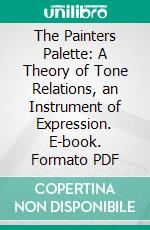Denman Waldo Ross eBooks
eBooks di Denman Waldo Ross di Formato Pdf
On Drawing and Painting. E-book. Formato PDF Denman Waldo Ross - Forgotten Books, 2017 -
IN beginning the study of any art we must learn what materials and terms are properly used in it and what modes of expression. Then we ought to have some practice in using the materials and terms and exercises in the different modes, following the example of the masters. This is equally true, whether we propose to practice the art as a profession or wish merely to understand and appreciate. Without some experience, without some technical knowledge and practice, our understanding is sure to be superficial and our apprecia tion limited. It is interesting to remember the passage of Aristotle in the Politics, 1 where he says: It is difficult, if not impossible, for those who do not perform to be good judges of the performances of others. They who are to be judges should also be performers. If we have never been performers we deny this proposition, in self-defence, but if we have ever practiced any art we know that we are better critics and better judges, just for that reason. Aristotle does not say that it is impossible for any one to be a good judge who is not also a performer. It is difficult, he says, if not impossible. Nor does he say that the performer is sure to understand; he is simply more likely to understand than any one who has never been a performer. We know, very well, how many performers there are who do not understand, who have neither appreciation nor judgment, and we are willing to admit that certain persons, not many, are good judges though they have had no technical training. We may be sure, however, that they would be better judges if they had had some training.
The Painters Palette: A Theory of Tone Relations, an Instrument of Expression. E-book. Formato PDF Denman Waldo Ross - Forgotten Books, 2017 -
With pigments and pigment-mixtures we are able to produce a great number and variety of effects, effects of light and of color, which we call the tones of the palette. In every tone thus produced there are two elements: there is the quantity of light in the tone that we call its value, and the quality of light in the tone that we call its color. The quantity of light in any tone and its color depend upon the pigments which we use in producing it. When two or more pigments are used, the tone depends, not only on the pig ments but on the quantities and proportions of them that are used.

